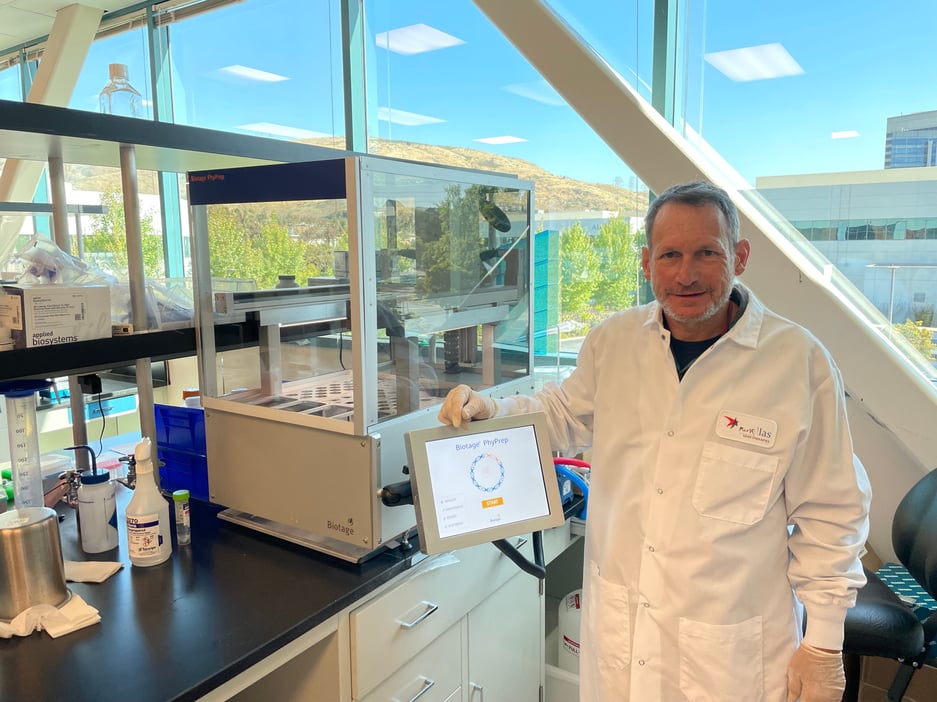Gene therapy has had its share of setbacks, but finally gene therapies are proving successful at treating diseases like neuromuscular disorders, cancer and blindness. Adeno-associated virus (AAV) has emerged as a leading gene delivery vehicle because it is efficient and has demonstrated safety in humans.
Although obstacles remain, optimism about AAV gene therapy has spurred an influx of potential gene therapies into the research pipeline. Biotage is helping to speed up the flow of research with automated systems such as their PhyPrep plasmid purification system.
 “PhyPrep was just extremely attractive for us for its walk away automation ability”
“PhyPrep was just extremely attractive for us for its walk away automation ability”
Mark Champe manages a gene therapy research lab in South San Francisco, previously called Audentes, which is now part of the Japanese pharmaceutical company Astellas Pharma. Before being acquired last year, Audentes Therapeutics had developed a gene replacement therapy for X-linked myotubular myopathy. X-linked myotubular myopathy is a devastating disease, causing extreme muscle weakness and respiratory failure. It is lethal in half the boys who have it and the other half will require a ventilator to breath and a wheelchair for mobility.
In clinical trials the Astellas gene therapy for X-linked myotubular myopathy has brought marked improvements for some kids. “The kids can get off the ventilator, they can stand up, walk around, throw balls. That’s just a striking example of what gene therapy can do”, says Champe.
Since being acquired by Astellas, Champe says that his workload has increased. Their research pipeline includes gene replacements and splicing modifications for neuromuscular diseases such as Duchenne muscular dystrophy, Friedrich’s ataxia and myotonic dystrophy. The main challenge he faces is throughput. “We have lots and lots of requests for plasmids from different groups and we’re constantly doing plasmid preps which had been time consuming and tedious the way we had been doing them.”
Plasmids are the common starting point for many therapies including DNA vaccines, monoclonal antibodies, viral vectors and mRNA vaccines. For Champe’s lab research group, preparing AAV vectors for gene therapy involves constructing DNA plasmids with the desired gene flanked by nucleotide sequences that will later instruct that gene to be packaged into AAV vectors.
The plasmids prepared by Champe’s research team, which contain the DNA to be introduced into AAV, are passed on to another team which transfects them into mammalian cells along with the helper plasmid. The helper plasmid contains the genes that encode viral proteins that are the structural components of the virus as well as DNA polymerase that makes the single stranded DNA of interest that goes inside the virus. The cells then produce AAV virus carrying the gene of interest which is collected and used either for animal or in vitro studies.
In order do the necessary research on gene therapy candidates Champe and his colleague need to prepare AAV plasmids in large quantities of around 10 milligrams (Giga scale), which is very labor intensive. “We were getting to the point where half the time was spent just doing plasmid preps”. Plasmid preps are a pain point many biomedical researchers can relate to.
To alleviate that pain in their research process Champe’s lab turned to Biotage which has an automated plasmid prep workflow solution. The Biotage automated PhyPrep system uses anion exchange columns, similar to the most commonly used manual plasmid purification kits, to capture negatively charged DNA. Both types of plasmid preps begin the same: growing the plasmids in bacteria, collecting bacteria cells by centrifugation, breaking those cells open by alkaline lysis and precipitating the proteins and chromosomal DNA.
Read our Annual report to learn more about our highlights in 2022. To read the full article on how Astellas Gene Therapies automated their plasmid purification , click on the button below.

 Organic Workflow
Organic Workflow Peptide Workflow
Peptide Workflow Scale-Up Flash Purification
Scale-Up Flash Purification  Sample Preparation
Sample Preparation Biomolecule Purification
Biomolecule Purification Oligo synthesis
Oligo synthesis Scavengers and Reagents
Scavengers and Reagents Service & Support
Service & Support Accessories & Spare parts
Accessories & Spare parts Investors
Investors Reports & News
Reports & News The Share
The Share Corporate Governance
Corporate Governance Calendar
Calendar Sustainability
Sustainability Our Offering
Our Offering Our History
Our History Our Locations
Our Locations Leadership
Leadership